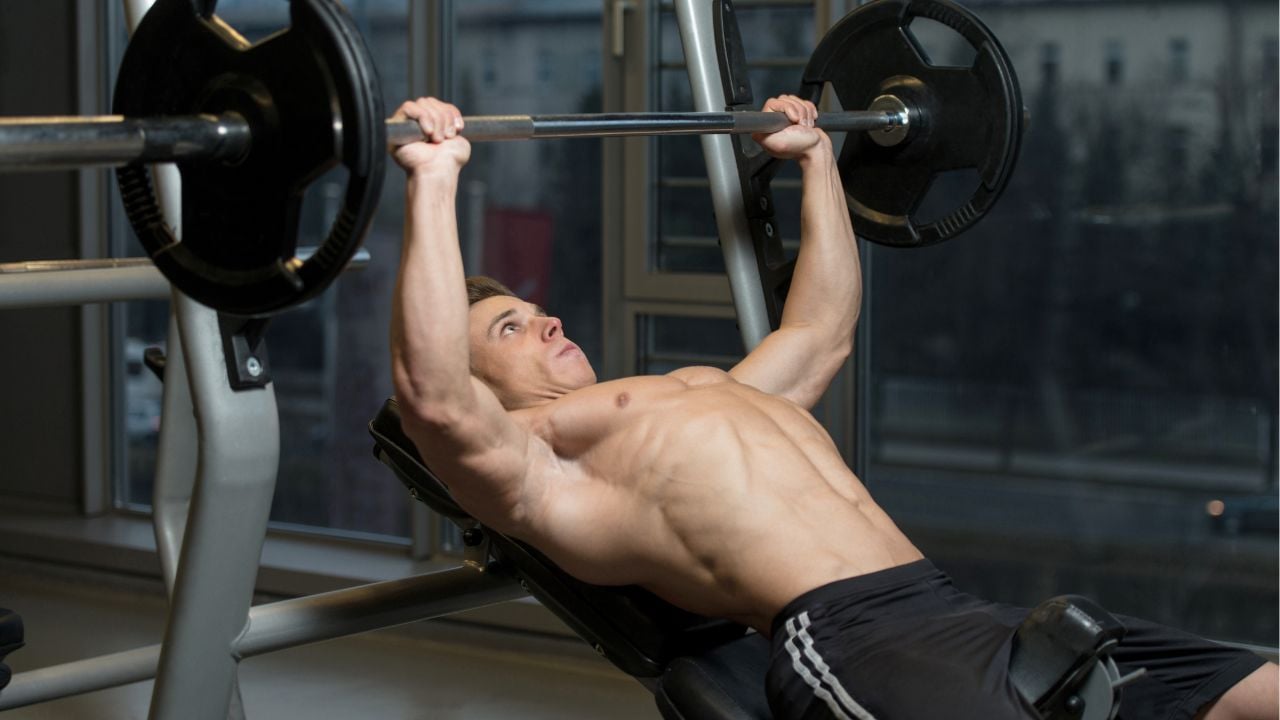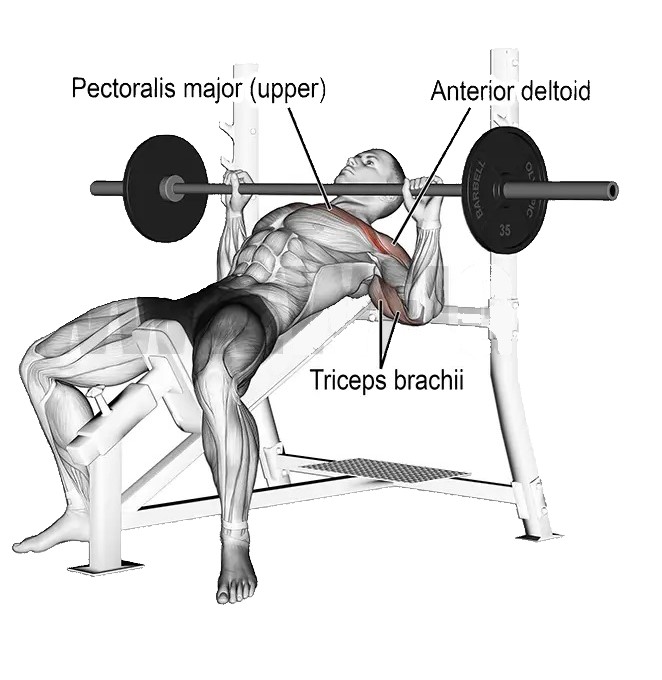An incline barbell bench press is a variation of the traditional flat barbell bench press, in which the bench is set to an inclined position.
The inclined angle effectively targets your upper chest muscles even more intensely than the standard flat bench press. It also trains the triceps and the front part of the shoulders (anterior deltoid muscles of the shoulders.)
But there’s one major problem: The front deltoid likes to dominate the movement due to the incorrect angle of the bench set-up.
Now the question is, how correct?
Research shows that the best way to work on the upper part of your chest is to do the incline bench press at a 30-degree angle.
Even though 30 degrees may seem like a small angle, it is the proper angle to train your upper pecs and minimize the effect on the anterior deltoid muscles.
If you set the incline bench press angle to 60 degrees, people will use it for an incline bench press, then you will shift the focus from the upper chest to the anterior deltoid.
An upright position will focus the front delts more because the arms move in a straight line up against gravity in an overhead pressing motion.

Incline Barbell Chest Press Muscles Worked
The incline barbell bench press primarily works the upper pectoralis major muscles and targets the main pec muscle.
The incline chest press involves several synergist muscles,
A handful of other muscles worked or play the role of stabiliser muscles, including your
- Biceps brachii,
- Brachialis,
- Triceps brachii,
- Wrist flexors,

How To Do Incline Barbell Bench Press
- Set the incline bench to your desired angle (30–45 degrees is standard; a steeper angle hits the shoulders more) and position it correctly within the squat rack or bench press station.
- Adjust the rack height so that when you’re lying down, you can unrack the bar with only a slight bend in your elbows—you shouldn’t have to fully extend or overreach.
- Lie down on the bench. Plant your feet firmly on the floor to maintain contact throughout the lift.
- Arch your upper back slightly, pulling your shoulder blades back and down into the bench. This creates a stable shelf for pressing and protects your shoulder joints. Maintain a slight natural curve in your lower back.
- Grip the barbell slightly wider than shoulder width. When the bar is at the bottom position, a good starting point is often where your forearms are roughly vertical.
- Wrap your thumbs securely around the bar (full grip). Avoid a thumbless/suicide grip, especially on an incline, where the bar path can be less predictable. Ensure your grip is even on both sides.
- Take a deep breath, brace your core hard (like preparing for a punch).
- Have a spotter help you lift the bar off the rack, or if alone, push it straight up just enough to clear the hooks.
- Bring the bar forward slightly so it’s stable directly over your upper chest/clavicle area, with arms extended but not hyper-locked.
- Inhale slowly and lower the barbell towards your upper chest (near the clavicles). Keep your elbows tucked slightly (roughly 45–60 degrees relative to your torso).
- Pause briefly (optional, but prevents bouncing). Exhale forcefully as you drive the barbell back up. Push yourself back into the bench as you press the bar away.
- The bar path should move slightly backwards, ending over the starting position above your upper chest/clavicles.
- After completing a set, safely rack the barbell.
Proper Form And Tips
The Barbell Incline Press is a powerful compound lift—but only if done with proper form. I’ve seen countless lifters leave gains on the table (or worse, get injured) because they overlooked technique.
- Set the bench to an incline of about 30 to 45 degrees. This angle targets the upper chest without putting too much stress on the shoulders.
- Maintain three points of contact—head, upper back, and glutes firmly on the bench.
- Ensure that the shoulder blades remain retracted and that they do not change position as you press.
- Grasp the barbell with a grip slightly wider than shoulder-width. Your wrists should be straight and aligned with your forearms.
- Unrack the barbell with your arms fully extended above your chest. Keep the tension in your chest as you press the weight up.
- Inhale as you slowly lower the barbell around the level of your collarbones. Keep your elbows at a 45-degree angle to your torso. Exhale while pushing barbells upwards, and do so in a controlled manner.
- Maintain a controlled tempo throughout the exercise. Avoid any jerky or rapid movements.
- Always use the longest range of motion possible and control the barbells throughout the set.
- For beginners, it is best to wrap your thumbs around the bar when bench pressing. More experienced lifters may use a “suicide” grip with thumbs behind the bar, but this grip requires extra control and carries a higher risk.
- Test different grip widths to find what works best for you. People with longer arms may need a slightly wider grip. If you feel pressure in the front of your shoulder while doing this exercise, try another one.

Sets And Reps
Training volume refers to the total amount of work you perform during a chest workout, including the number of sets, reps, and weights used.
Here’s a good starting point for how many sets and reps you should do.
Sets
According to the latest scientific evidence, 12–20 weekly sets per muscle group may optimise muscle growth.
- Beginners (with a year or less of training) should aim for about 10-12 weekly sets
- An Intermediate trainee (with two to four years of training) can increase the volume to 16 sets per week.
- An advanced trainee (four or more years of training) may be able to get in up to 20 weekly sets.
When a certain amount of volume stops working and your progress stops, you can add sets to increase the volume and use that to make progress again.
Reps
The best rep ranges and loads to work with.
- For muscle endurance: Aim for 15-20+ reps with moderate resistance.
- For muscle strength: 6–10 reps, with more resistance.
- For muscle hypertrophy (increased muscle size): Aim for 3–4 sets of 8–12 reps, with a moderate to heavy amount of resistance.
It’s best to start with fewer reps and sets first, then increase them as you get stronger.
References
- Influence of bench angle on upper extremity muscular activation during bench press exercise. Lauver, J. D., Cayot, T. E., & Scheuermann, B. W. (2015). European Journal of Sport Science, 16(3), 309-316. doi:10.1080/17461391.2015.1022605. URL: https://www.tandfonline.com/doi/full/10.1080/17461391.2015.1022605, accessed on 24.08.2020
- An Electromyography Analysis of 3 Muscles Surrounding the Shoulder Joint During the Performance of a Chest Press Exercise at Several Angles. Trebs, A. A., Brandenburg, J. P., & Pitney, W. A. (2010). Journal of Strength and Conditioning Research, 24(7), 1925-1930. doi:10.1519/jsc.0b013e3181ddfae7

Manish is a NASM-certified fitness and nutrition coach with over 10 years of experience in weight lifting and fat loss fitness coaching. He specializes in gym-based training and has a lot of knowledge about exercise, lifting technique, biomechanics, and more.
Through “Fit Life Regime,” he generously shares the insights he’s gained over a decade in the field. His goal is to equip others with the knowledge to start their own fitness journey.
